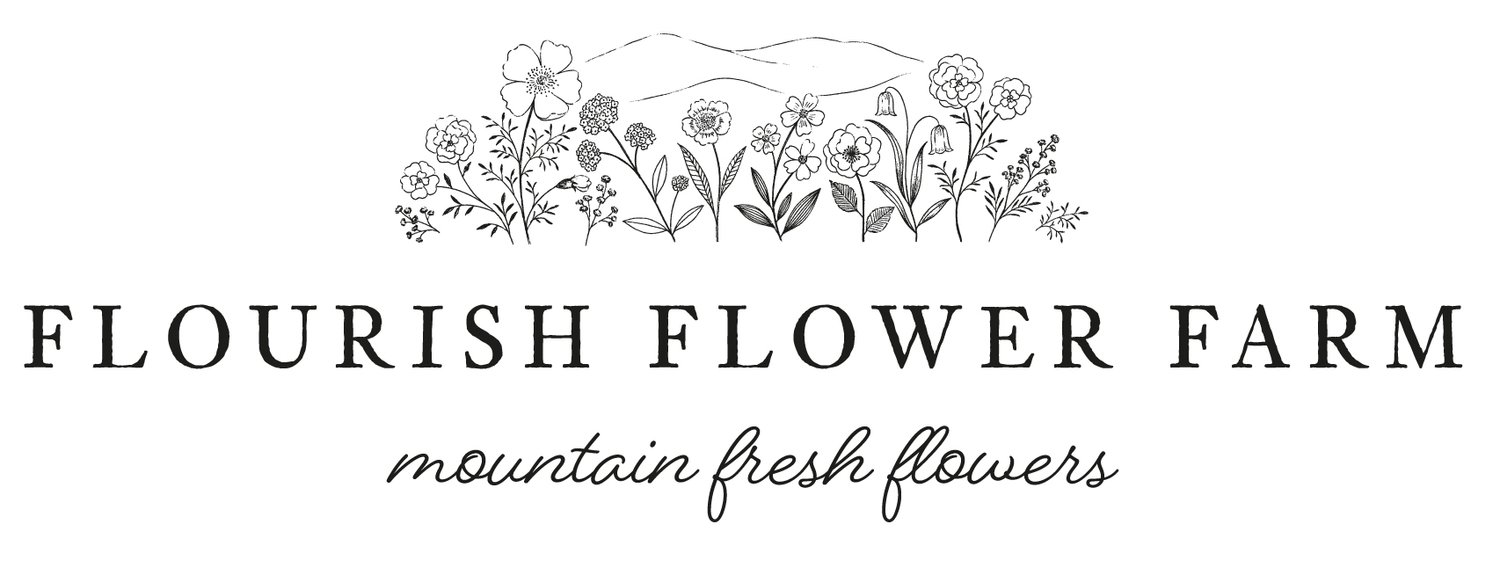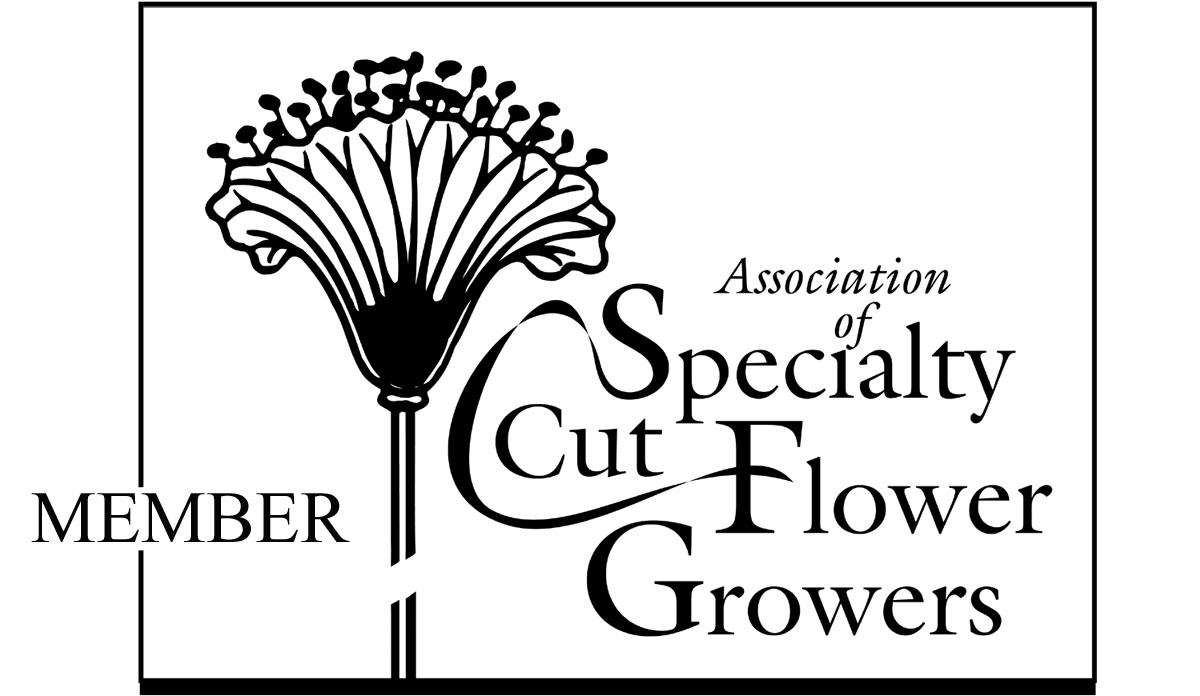Growing Guide: Lavender
/Lavender is one of those magical plants that brings beauty AND fragrance to the garden. It’s a favorite for us at the farm (including the bees!) to use in bouquets, to dry, and to distill into lavender hydrosol and essential oils.
At Flourish, we grow the variety ‘Phenomenal.’ It’s a hardy, versatile lavender that thrives in our climate and is surprisingly low maintenance once established.
In this guide, we’re sharing how we grow lavender for cutting, including planting tips, harvesting advice, and how to dry lavender bundles.
Why We Love Growing Lavender
Lavender offers so much for flower growers and gardeners alike:
It’s drought-tolerant and thrives in hot, dry conditions once established
The silvery foliage looks beautiful even when not in bloom
Lavender attracts pollinators and beneficial insects
Dried stems hold their color and fragrance for months
Growing using organic methods allows us to use it in all sorts of culinary endeavors and beverages
The smell! It is one of our absolute favorite scents, especially from fresh blooms.
Types of Lavender & Their Growing Preferences
I’ve heard many gardeners, especially here in the South, say they feel intimidated by lavender, particularly if they’ve struggled to grow it successfully in the past. Often, it’s simply a matter of finding the right type of lavender for your region and conditions. Different varieties have different needs, and matching the plant to your environment can make all the difference.
Not all lavender varieties thrive in the same conditions. Here’s a quick guide to some common types:
English Lavender (Lavandula angustifolia): This is a classic choice for colder climates. English lavender is hardy and produces highly fragrant flowers. It prefers full sun and well-drained soil and can tolerate cooler temperatures better than other types.
French Lavender (Lavandula dentata): Known for its soft, fringed leaves and longer bloom time. French lavender is less cold hardy and does best in warmer climates with mild winters. It prefers full sun and plenty of protection against frost.
Spanish Lavender (Lavandula stoechas): Recognized by its distinctive “rabbit ear” bracts at the top of each flower spike. Spanish lavender thrives in hot, dry conditions but is the least cold-tolerant of the common varieties. It’s ideal for containers or gardens in warmer regions.
Lavandin (Lavandula intermedia): A hybrid of English and Portuguese lavender. Lavandin produces large plants with long stems and abundant blooms, making it popular for cut flowers, as well as for drying. It prefers full sun and excellent drainage and can handle heat and humidity better than true English lavender.
Phenomenal is a Lavandin variety that works well for us here in zone 6b/7a because of its resilience and suitability for our growing conditions. We experience hot, humid summers (reaching the high 80s), fairly cold winters (can dip into the teens and single digits for a week at a time), and typically wet conditions since we receive plenty of rainfall. We’ve found that Phenomenal holds up well in our climate.
Planting Lavender for Cutting
Our entire farm and growing fields are situated on a slope, which helps with drainage. Here’s what has worked for us with growing lavender:
Variety: We grow Phenomenal, which is known for its cold hardiness, resistance to humidity, and reliable performance as a cut flower. The stems on Phenomenal are longer, reaching about 24-32” tall, than other varieties that also do well in our climate, such as Grosso. Phenomenal has a phenomenal fragrance (pardon the pun) and is also great for producing essential oil.
Site: Choose a sunny spot with excellent drainage. A slope or raised bed can help prevent root rot.
Soil: Lavender prefers well-drained soil. Avoid wet conditions and avoid over-fertilizing. In fact, we have never fertilized our lavender in the 5 years that it has been growing on our farm!
Spacing: Give plants plenty of room to breathe. We space ours 2 to 3 feet apart. The plants practically double in size between years 3-4.
Fabric: We plant into landscape fabric to help with weed suppression and moisture regulation. Make sure to burn or cut the planting holes large enough to accommodate the plants as they grow. We recommend about 12” round.
Maintenance: Lavender is generally pest-resistant, but watch out for overwatering and root rot. More on pruning later.
Timing: Either spring or fall planting works well, giving roots time to establish before extreme temperatures. We’ve had the best success planting in the spring, mostly because the pesky deer tend to leave them alone. One year, we fall-planted lavender plugs only to have the deer pluck each one out of the ground. The deer dropped the plugs on the ground once they realized they were not tasty to eat, leaving the tiny plugs to dry out in the sun!
Harvesting & Drying Lavender
Our established plants typically begin blooming in early summer, but patience pays off with lavender. Plants usually take 2 to 3 years to reach their full cutting potential. Once they do, here’s how to get the best from your crop:
Harvest when about half the buds on a stem have opened for the best fragrance and longevity. The florets are typically a brighter purple color. Fresh lavender doesn’t have the longest vase life, about 4 days, but it can be enjoyed fresh and then dried after.
Cut in the morning after the dew has dried, but before the heat of the day. Or harvest later in the evening.
Bundle stems and hang them upside down in a cool, dry, dark place to preserve color and scent. We create bundles that are about 8” in diameter and hang them in our non-climate-controlled barn.
A Few Final Tips
Lavender is happiest when it’s a little neglected. Overwatering and over-fertilizing are common mistakes.
Plants will start to become bushy and fill in beautifully after a few seasons, giving you more flowers for harvesting.
Regular pruning helps keep plants tidy and productive. We trim ours lightly after flowering to maintain shape. Our favorite tool to trim is an electric-powered hedge trimmer. We shape the plants by using a swooping, rounded motion all around the plant. Be careful not to trim into the “woody” parts of the plant.
Lavender is a perennial investment that rewards you with beautiful flowers and an amazing scent season after season. Whether you’re growing for fresh arrangements or dried creations, lavender is a wonderful addition to any flower farm or cutting garden. Lavender season is one of our favorite times of year on the farm!














